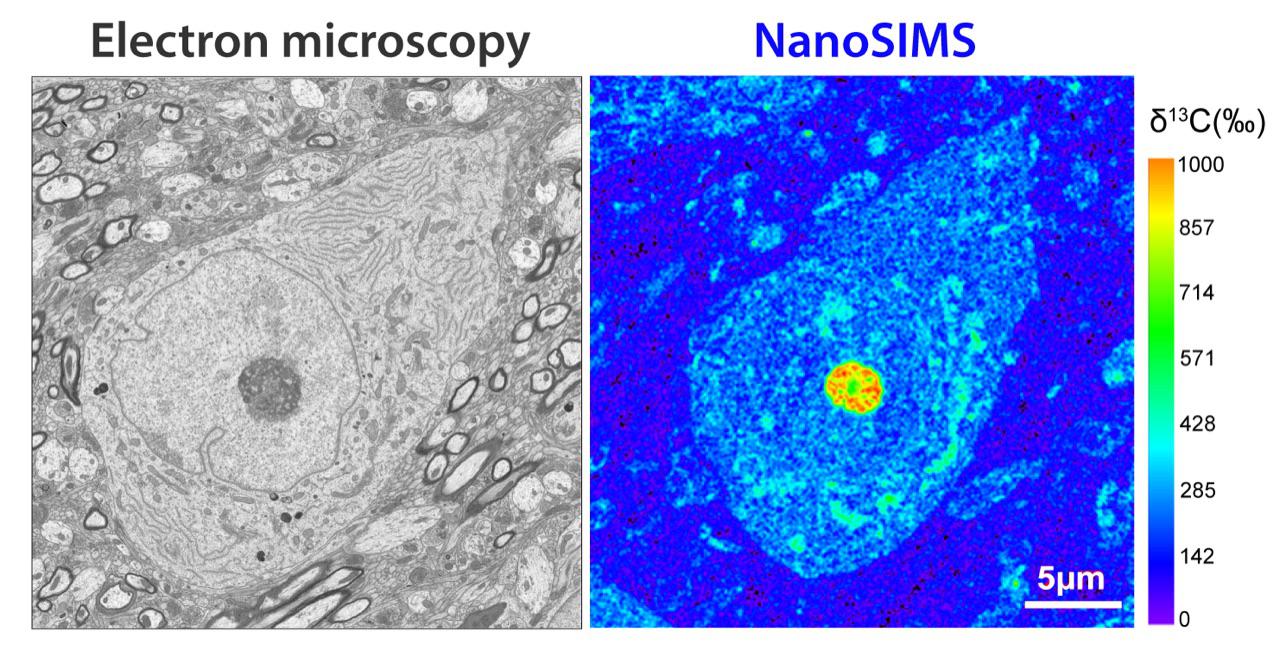A deep look into the progression of Parkinson's Disease

The CryoNanoSIMS setup at EPFL. Credit: 2023 EPFL/ A. Meibom- CC-BY-SA 4.0
Scientists at EPFL use cutting-edge imaging techniques to shed light on the progression of Parkinson's disease by studying how the main culprit, the protein alpha-synuclein, disrupts cellular metabolism.
Parkinson's disease is a complex neurodegenerative disorder that leads to the deterioration of specific types of neurons in the brain, resulting in a number of motor and non-motor symptoms. It is currently estimated that more than 10 million people in the world are living with Parkinson’s disease, the second most common neurodegenerative disorder after Alzheimer’s. That number is expected to swell up to 14 million by 2040 in what is being referred to as the Parkinson’s pandemic.
One of the key events in Parkinson's disease is the accumulation of a protein called alpha-synuclein inside neurons. That accumulation disrupts the normal functioning of the cells, giving rise to the symptoms of Parkinson’s and other disorders, and progresses into aggregates called Lewy bodies.
In a new study, researchers from two labs at EPFL have combined their expertise to explore how alpha-synuclein disrupts metabolic processes within neurons. The study is a truly interdisciplinary collaboration between the Bertarelli Platform for Gene Therapy of Bernard Schneider and the group of Anders Meibom at EPFL, with support from EPFL’s Bioelectron Microscopy Core Facility.
The researchers used cutting-edge imaging techniques, including an analytical instrument called NanoSIMS (Nanoscale Secondary Ion Mass Spectrometry). NanoSIMS is an “ion microprobe” that combines high spatial resolution (50-150 nm), high-resolution mass spectrometry, and high analytical sensitivity, which allow it to produce sub-cellular maps of metabolic turnover with extreme sensitivity. Meibom’s lab at EPFL has famously used NanoSIMS for a number of ecological and geological studies.
In this study, the researchers combined NanoSIMS with stable isotope labeling, to visualize isotopic variations within tissues at high resolution, providing insights into the metabolic activity of individual cellular compartments and organelles. They combined this with Electron Microscopy to “see” more information from biological samples. ![]()

To model Parkinson's disease, the team used genetically modified rats that overexpressed human alpha-synuclein in one hemisphere of the brain, leaving the other healthy as a control. By comparing the neurons overexpressing alpha-synuclein to those in the control hemisphere, the scientists uncovered significant changes in the way carbon molecules are incorporated and processed within neurons.
One of the most remarkable findings was the effect of alpha-synuclein on the turnover of carbon within neurons. Neurons overexpressing alpha-synuclein showed a heightened overall turnover of macromolecules, suggesting that the accumulation of alpha-synuclein may lead to increased metabolic demands on these cells.
The study also found changes in the distribution of carbon between different cellular compartments, such as the nucleus and cytoplasm, which may be influenced by alpha-synuclein's interaction with DNA and histones.
The metabolic disruptions caused by alpha-synuclein also seem to affect specific organelles: Mitochondria, for example, showed abnormal carbon incorporation and turnover patterns, which agrees with previous studies showing that alpha-synuclein impairs mitochondrial function. Similarly, the Golgi apparatus – responsible for cellular trafficking and communication – exhibited metabolic defects that were likely caused by alpha-synuclein disrupting inter-organelle communication.
“This study shows the potential of the NanoSIMS technology to reveal metabolic changes in the brain, with unprecedented resolution, at the subcellular level,” says Bernard Schneider. “It hands us a tool to study early pathological changes occurring in vulnerable neurons as a consequence of alpha-synuclein accumulation, a mechanism directly linked to Parkinson’s disease.”
Other contributors
- Universiteit Utrecht Department of Earth Sciences
- University of Lausanne Center for Advanced Surface Analysis
Dementia Research Switzerland - Synapsis Foundation
Sofia Spataro, Bohumil Maco, Stéphane Escrig, Louise Jensen, Lubos Polerecky, Graham Knott, Anders Meibom, Bernard L. Schneider. Stable isotope labeling and ultra-high-resolution NanoSIMS imaging reveal alpha-synuclein-induced changes in neuronal metabolism in vivo. Acta Neuropathologica Communications 29 September 2023. DOI: 10.1186/s40478-023-01608-8